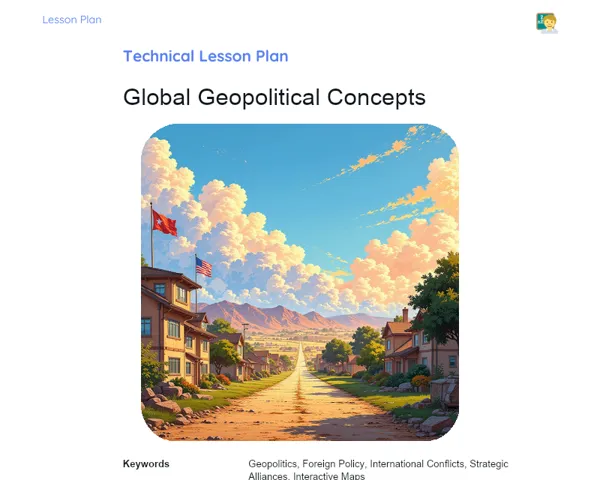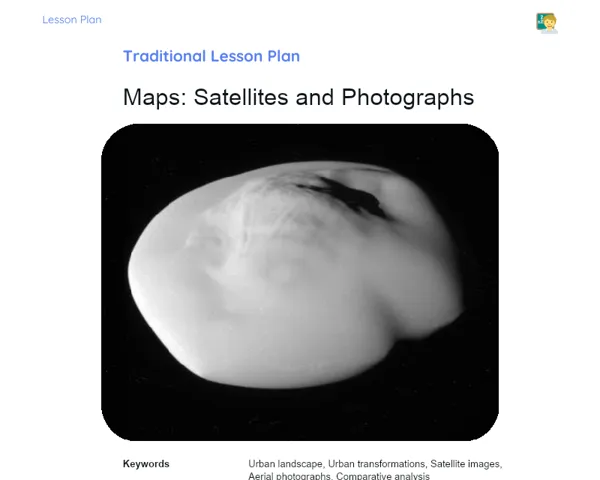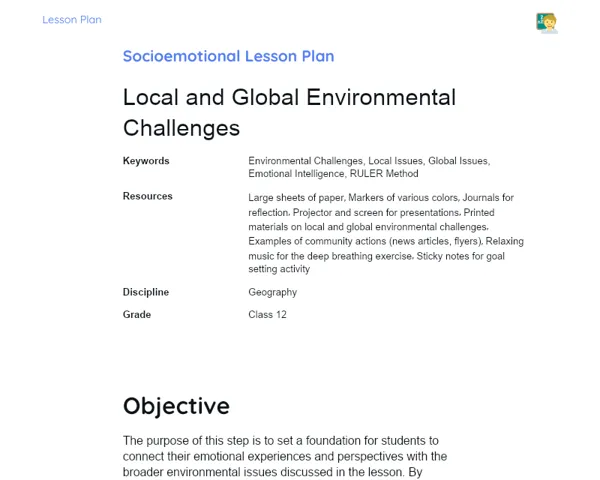Lesson Plan Teknis | Changes and Continuities
| Palavras Chave | Changes and Continuities, Critical Analysis, Historical Images, Timeline, Observation, Teamwork, Reflection, Geography, Job Market, Urban Planning, Architecture, Local History |
| Materiais Necessários | Projector, Old and recent images of a location, Kraft paper, Coloured markers, Glue, Scissors, Sheet with before and after images of a location, Drawing paper |
Objective
Duration: (10 - 15 minutes)
This stage aims to familiarize students with the concepts of changes and continuities over time, using images to make understanding easier. By developing practical skills in analysis and observation, students will be better equipped to grasp spatial and temporal transformations, which are essential skills for their academic journey and future careers.
Objective Utama:
1. Analyze images of the same place at different times, identifying changes and continuities.
2. Develop critical observation skills by comparing different temporal periods of a location.
Objective Sampingan:
- Spark students' curiosity and enhance critical thinking.
- Encourage active and collaborative participation in the activities.
Introduction
Duration: (10 - 15 minutes)
This stage is designed to introduce students to the concept of changes and continuities over time, utilizing images as a tool for clearer understanding. By honing practical skills in analysis and observation, students will be well-prepared to understand spatial and temporal transformations, garnering important skills for both academic settings and future employment.
Curiosities and Market Connection
Did you know that professionals like urban planners and architects rely on historical photos and maps to strategize new projects and renovations in cities? They must discern what has changed and what has remained consistent over the years to make informed choices. Historians and geographers also use these insights to explore societal and environmental evolution.
Contextualization
Changes and continuities are key concepts that help us understand how places and landscapes evolve over time. Consider your own neighborhood: has it always looked the same? Unlikely. Cities expand, new buildings go up, trees are planted or removed, yet some elements like roads or historical monuments stay constant. Understanding these transitions aids us in appreciating our history and planning wisely for the future.
Initial Activity
Display two pictures of the same place—one from the past and one recent—and ask students, 'What differences and similarities do you see?' Allow them to share their initial thoughts. This warm-up discussion will ignite their curiosity about the subject.
Development
Duration: (50 - 60 minutes)
This stage is intended to help students deepen their understanding of changes and continuities over time through practical, reflective activities. By working in groups and discussing their findings, students will enhance their analysis, communication, and collaboration skills, which are crucial both in school and in the workforce.
Topics
1. Understanding the concepts of changes and continuities.
2. Recognizing changes and continuities in images.
3. The significance of changes and continuities for society.
4. Careers that leverage the analysis of changes and continuities.
Thoughts on the Subject
Encourage students to think about how changes and continuities impact their everyday lives. Prompt them to consider how the places they often visit, like their school or parks, have evolved over time, as well as what aspects have remained the same. Discuss how these changes influence their daily lives and overall well-being.
Mini Challenge
Creating the Neighborhood Timeline
Students will design a visual timeline of a neighbourhood using old and recent images supplied by the teacher. They'll pinpoint changes and continuities through the years.
1. Divide the class into groups of 4 to 5 students.
2. Hand out old and recent images of the same neighbourhood to each group.
3. Provide them with kraft paper, coloured markers, glue, and scissors.
4. Instruct the students to analyze the images and note the changes and continuities.
5. Guide them in assembling a timeline on the kraft paper by pasting the images and marking the observed changes and continuities.
6. Encourage each group to present their timelines to the class, elaborating on their observations.
Foster critical observation and analysis skills, while promoting teamwork and effective communication.
**Duration: (30 - 40 minutes)
Evaluation Exercises
1. Have students sketch a familiar place (like their home, school, etc.) as it was in the past and how it is today, marking changes and continuities.
2. Distribute a sheet with a before and after image of a well-known location. Ask students to circle the changes and underline the continuities.
3. Initiate a discussion circle where each student shares a notable change they've observed in their community and a significant continuity.
Conclusion
Duration: (10 - 15 minutes)
The goal of this stage is to solidify students' learning, ensuring they grasp the importance of the concepts discussed and learn how to apply them in real-world settings. The final discussion and summarization of main points serve to reinforce knowledge and consider its applications in everyday life and the job market.
Discussion
Conclude with a group discussion about what students have learned throughout the class. Ask how practical activities aided their understanding of changes and continuities. Encourage students to reflect on how this knowledge can be relevant in their daily lives and future careers. Pose questions like, 'How do you feel changes and continuities affect our lives?' and 'How can the lessons learned today be applied in the future?'
Summary
Summarize the key points covered in the lesson: the definitions of changes and continuities, the significance of these concepts for understanding the evolution of places over time, and the various professions that utilize such analyses. Emphasize how critically analyzing images from different time periods can provide valuable insights into the history and development of locations.
Closing
Clarify to students how the lesson bridged theory with practice, showing that changes and continuities are not merely academic concepts but practical tools in the job market. Stress the importance of observing and analyzing the world around us, highlighting the value of this skill in daily life and a variety of careers. Conclude by thanking everyone for their active participation and reiterating the relevance of the topic.



